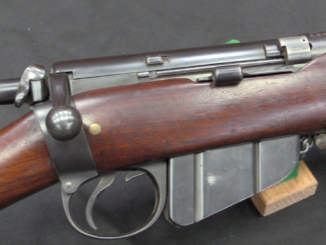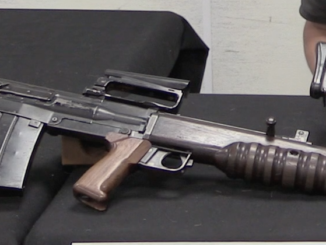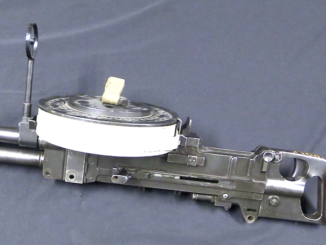While rifle-launched grenades date back hundreds of years, they first came into widespread use during World War One, on all sides of the conflict. The first years of the war saw the use of rod grenades, but their downsides (mediocre accuracy, bulkiness, and a propensity to damage rifle bores) led to the British adopting a 2.5” cup grenade discharger in late 1917. This new launcher used slightly modified Mills bomb hand grenades, and could launch them with significant accuracy from 80 to 200 yards. They would become a staple of WWI combined arms infantry tactics, and be used clear through WW2 until replaced by the 22mm NATO style spigot grenades.
Related Articles

Bolt Action Rifles



Well this rifle is definitely reserved for grenade launcher duty. The stock is wrapped with wire. I can imagine that a volley of grenades would be quite annoying to anyone on the receiving end. However, the designated grenade guys would be deprived of their long arms and thus would need side arms like revolvers or privately purchased semi automatic pistols (a Colt M1911 would do nicely).
“grenade guys would be deprived of their long arms”
This finally lead, much much later, to development of under-barrel grenade launchers, anyway it must be considered worth its price, as several armies during WWII maintained rifle grenade launching ability
You know that rifles like the Mas 49 family, Beretta AR70/90, the FAL, some SKS, STGW57, and even the FAMAS were able to shoot 22mm rifle grenades. Brazil even made Mauser bolt action rifles with the same flash hider as their FALs, which meant they too could shoot that rifle grenade. Most of the time, all you had to do was to close the gas block (lever in the MAS, rotate plug in FAL/FN-49, nothing at all in the STGW57 since it had no gas system), insert grenade, put blank/grenade specific round which usually came with grenade, set sights as needed, and shoot. After it went away, open gas system, lower grenade sights as needed (Brazilian FALs used a sight attached to the grenade that would fall off during firing), and back to pew pew pew.
AFAIK, French soldiers tend to carry 3 rifle grenades on them just in case. Don’t know nowadays though since they retired the FAMAS.
Meanwhile, the under-the-barrel grenade US military likes so much is an entire firearm added to your rifle. Which one is more complicate? Which one is heavier/more convenient to the soldier?
Rifle still works fine with ball.
EY grenade rifles (It stood for “EmergencY use only”)were quite capable of being fired with ball ammunition. The major problem with them was that sustained firing of the heavy weight of the 36M Mills caused splitting of the stock and forearm (hence the wire binding) and distortions of barrel and action bedding.
The bedding problems meant that accuracy was generally not up to minimum standard (1″ 3-shot group at 100 yards off the rest). Shooting beyond 400 yards (a rare event anyway) was inadvisable with ball rounds, and overhead support fire (over friendly troops) was prohibited due to vertical dispersion from line of sight.
In short, an EY SMLE tended to shoot like a standard one with a badly worn bore.
cheers
eon
One of the most used but least covered combat weapons of WWI and WWII. Thanks Ian.
I would love to get my hands on an inert grenade to go with mine. And I can say that the rifle shoots ball ammo just fine without the cup in place.
I have a lot of fun with mine. Using a tennis ball, original military spec blank (not the ballisite grenade blank) aim in the general direction and have fun between 30-100yds depending on the blank and brand of tennis ball.
Also great fun for launching tennis balls. Can get 3 shots per tennis ball by rotating it 90° after each launch, as a blank will punch a a hole right thru the ball. Make sure you have the proper Walsrode grenade launching blanks if firing even an inert grenade, as conventional blanks will blow up the rifle…
“punch a a hole”
BTW: Russia Дьяконов grenade-launcher fired grenades using live cartridges – these grenades has hole bit bigger than bullet which allows passing of bullet, see 4th image from top here: http://www.battlefield.ru/soviet-rifle-grenade.html
I know the germans fitted a silencer in place of the grenade launching tube on the Kar 98 mauser but that tube was only about 30 mm in diameter so regular sites could be used
I wonder if this british system was ever ued for fitting a silencer to the lee-enfield maybe BIG rubber wipes
I’ve seen a Home Guard Training Manual from around 1941. Its grenade instruction shows a Mills Bomb with the gas seal disk attached. This with no mention of cup launchers.
I gather, therefore, that the ‘rifle grenades’ produced may have been issued for general use as well. Easier than trying to manage a split inventory. But I don’t recall any pictures of WWII grenade use where the disk was visible.
My father was a member of the Church Gresley .Derbyshire,Home Guard.We had two
Lee Enfields in the house,one standard issue and one EY model.It was my job to clean and oil them using the kit fitted in the stock.The EY had a cup which clipped on the end of the barrel.I seem to remember that the breech was enlarged to take a charge.I was only 6 or 7 years old at the time.The local HG platoons used to meet at Swadlincote on a Sunday morning to compete against each other using a large glazed sewer pipe as a target. Needless to say the Mills bombs and grenades were duds but there was a loud cheer when someone scored a direct hit.
Whether smle cup grenade launcher work with 70mm 12 bore gun, pag
Burma, 1945
The EY Rifles were carried in war reserve stocks at least until the late Sixties
http://www.milsurps.com/content.php?r=348-Myths-and-Truths-of-No.1-EY-Rifles-%28by-Peter-Laidler%29
The Americans and French used a similar device known as the Vivien-Bessieres
(which Ian has covered)
https://www.forgottenweapons.com/american-viven-bessieres-ww1-grenade-launcher/#:~:text=The%20standard%20American%20grenade%20launching%20system%20in%20World,pass-through%20type%20of%20grenade%20and%20standard%20ball%20ammunition.